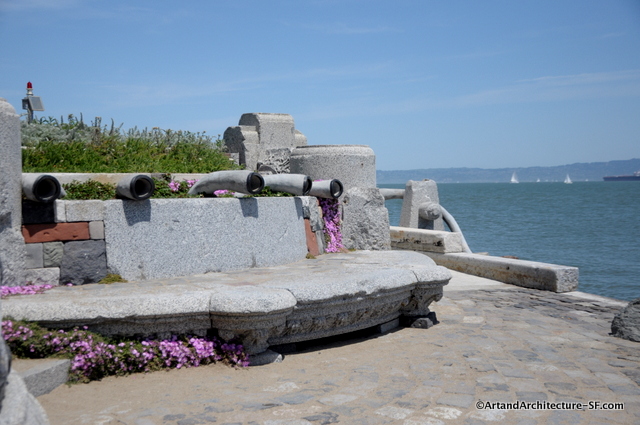In 1980, Richards (a Senior Artist at the Exploratorium for many years) received a planning grant from the National Endowment for the Arts that enabled him to conduct an extensive period of investigation into the physicality of the Wave Organ phenomenon.
The Wave Organ is located on a jetty that forms the small Boat Harbor in the Marina district of San Francisco, walking distance from the Exploratorium. The jetty itself was constructed with material taken from Laurel Hill Cemetery, providing a wonderful assortment of carved granite and marble, which was used in the construction of this piece. The installation includes 25 organ pipes made of PVC and concrete located at various elevations within the site, allowing for the rise and fall of the tides. Sound is created by the impact of waves against the pipe ends and the subsequent movement of the water in and out of the pipes. The sound heard at the site is subtle, requiring visitors to become sensitized to its music, and at the same time to the music of the environment. The Wave Organ sounds best at high tide.
Laurel Hill Cemetery also called Lone Mountain: A “who’s who” of early San Francisco occupied the guest list of the “silent city” including: Andrew Halladie, the inventor of the cable car; David Broderick, the popular US senator, who was killed in a duel at Lake Merced by the Chief Justice of the State Supreme Court; James King of William, whose assassination resurrected the Vigilantes in 1856; Senators Latham, Baker, Sharon, Fair and even Napoleon’s son.
Classical marble tombs and elaborate monuments glorified the affluent departed while a more humble section was reserved for the poor. A vault in the cemetery was devoted to the Chinese, but when “the Chinese must go!” movement gathered steam in 1870s, it was “bespattered with mud and filth, battered with stones and sometimes defaced in a most irreverent manner. The animosity that people bear towards the living, seems to extend even beyond the grave.”
Until Golden Gate Park came of age, Lone Mountain Cemetery served as a park where families would picnic and young couples would promenade among the dead.
Lone Mountain Cemetery was so successful that during the 1860s three other cemeteries were developed to the south, on the slopes adjacent to Lone Mountain. To avoid confusion, it made sense that Lone Mountain Cemetery, which was not located on Lone Mountain, changed its name to Laurel Hill in 1867. Western Neighborhood Projects

I saw a similar concept of an organ in Blackpool, UK but the tide was out so I didn’t get to hear it.
Wow now thats really interesting. If I ever get the chance to visit San Fran I will have to make a point to see and hear this.
Wow, this sound like fun! That is quite a fascinating history of the cemetaries.
Love how flowers are now growing on the wave organ…
Wow! Lovely to see SF on such a clear blue day!
As always thanks for the interesting nuggets of information 🙂
xo
I have yet to see or hear the wave organ.,,,one of these days. I know the Presidio has cemeteries, but I assume its a military cemetery and could be under a different jurisdiction. Interesting to hear families used to picnic in cemeteries. Seems like an odd thing to do.
[…] phenomena as wind and tidal movement into a larger cultural context. Peter is responsible for the Wave Organ in the bay. He holds an MFA from the Rinehart School of Sculpture in Baltimore, Maryland and a BA […]
This is so cool! I’ve always wondered where the stone work came from. Awesome!